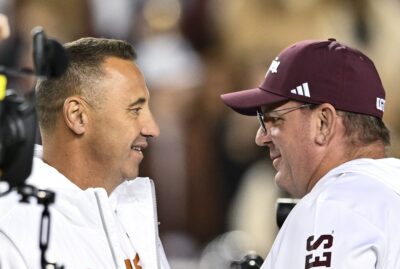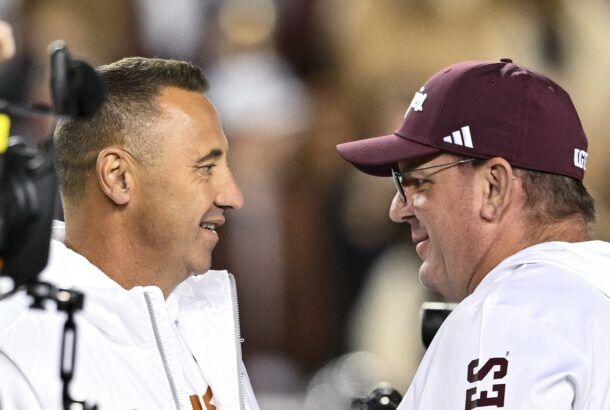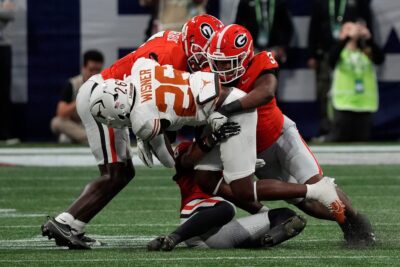Ad Disclosure
With most rule changes now on a two-year cycle, and this being considered the off year, there isn’t too much new regarding the 2014 season.
According to Rogers Redding, the national coordinator of College Football Officiating, this fall college football officials are being asked to pay special attention to two areas of the game that are of concern: Management of team personnel on the sidelines and the sportsmanlike behavior of players.
However, it’s the targeting rules designed to protect players that have drawn the most attention.
‘If you kind of split (last) season, if you look at the back half, we had five targets fouls,” SEC coordinator of officials Steve Shaw said. “That’s a significant reduction in comparison to the first eight weeks of the season where we had 14 targeting fouls. So the trend is good.”
With a little help from the National Football Foundation, here are the six biggest changes fans need to know:
1. Targeting fouls
Should a targeting penalty be overturned following a review on instant replay, the corresponding 15-yard penalty can also be removed. Last year the penalty stood, regardless.
“Anytime there’s a targeting foul you need to really listen to the referee’s announcement because here is what you will hear, and it’s a subtle part of his announcement that it makes all the difference for replay,” Shaw said. “If you hear him announce, ‘Personal foul, roughing the passer with targeting,’ now regardless of the review that 15‑yard penalty is going to stand for roughing the passer. Same thing, kick-catch interference with targeting, late hit with targeting.
“In that announcement if there are multiple components to the targeting foul, the 15‑yard penalty will stay in. Replay will not reevaluate a judgment like roughing the passer. If it’s multiple components and replay overturns it, the player goes back in, but we’ll still walk off the 15‑yard penalty.”
2. Targeting fouls in games without instant replay
In games instant replay is not used and there is no opportunity for an immediate video review, the referee to review a first-half foul at halftime when video is available at the game site.
3. Low hits on the quarterback
As an extension of the rule for roughing the passer, defenders are not allowed to make “forcible contact at the knee or below to an opponent who is in a passing posture.” The idea to limit knee injuries on plays where the defensive player forcibly drives a shoulder, helmet or forearm into the lower leg of the passer.
Defenders can still make a wrap-up tackle in which the contact is at or below the knee. Shaw compared it to almost having a physical strike zone on quarterbacks.
“This is a player safety thing,” he said. “I had to go to the dictionary and look up unabated. I’d encourage you to do the same thing. Basically what our officials are going to look at, when a player is under his own power, he is directing his own hit. If he chooses to go low, that is going to be a foul.”
4. Player numerals must contrast with the jersey
Should this occur the referee can ask the team to change into appropriate jerseys before the game begins. If the team does not change it will be charged with a timeout. The same opportunity will be offered during the time between the first and second quarters, at halftime and at the beginning of the fourth quarter, and again a timeout will be charged each time the team does not comply.
5. A tweak on being inbounds or out of bounds
A player has to establish himself as being inbounds or out of bounds.
Shaw explains: “Let’s say you were a defensive back, you were standing out of bounds, you leap from out of bounds, you went up in the air, secured possession of a pass, and landed inbounds. By the old rule that was an interception. Now you would have to establish yourself inbounds before going up and catching that ball.”
6. Enforcement of personal fouls
There’s a subtle change regarding penalties called on the defense during a pass completion, the penalty will now be marked off at the end of the entire play.
This season the SEC will also have a crew with eight officials as an experiment while considering if it should do so league-wide next year.
“I’ll make two observations,” Shaw said. “First is now the game is changed with spread offenses. You can have up to five receivers in a route and many times we get that. If you think about our officials, we have three deep, two wing officials, all have keys on these receivers. If they go out, they’re occupied with their key, that leaves the referee and umpire to handle all the other stuff in the middle. That’s a tall order.
“On top of that, what you see is a lot of times now with our up‑tempo teams, the umpire and the wing officials are not able to get their pre-snap routine. Our umpire is to count the offense, recognize the offensive formation, and then pick his keys from that offensive line and anticipate what’s getting ready to happen. Now a lot of times when we have substitutions, the umpire is having to stay at the ball, he can’t do his pre-snap routine. So the eighth official is to help us officiate better.”
Christopher Walsh has covered Alabama football since 2004 and is the author of 19 books. In his free time, he writes about college football.




